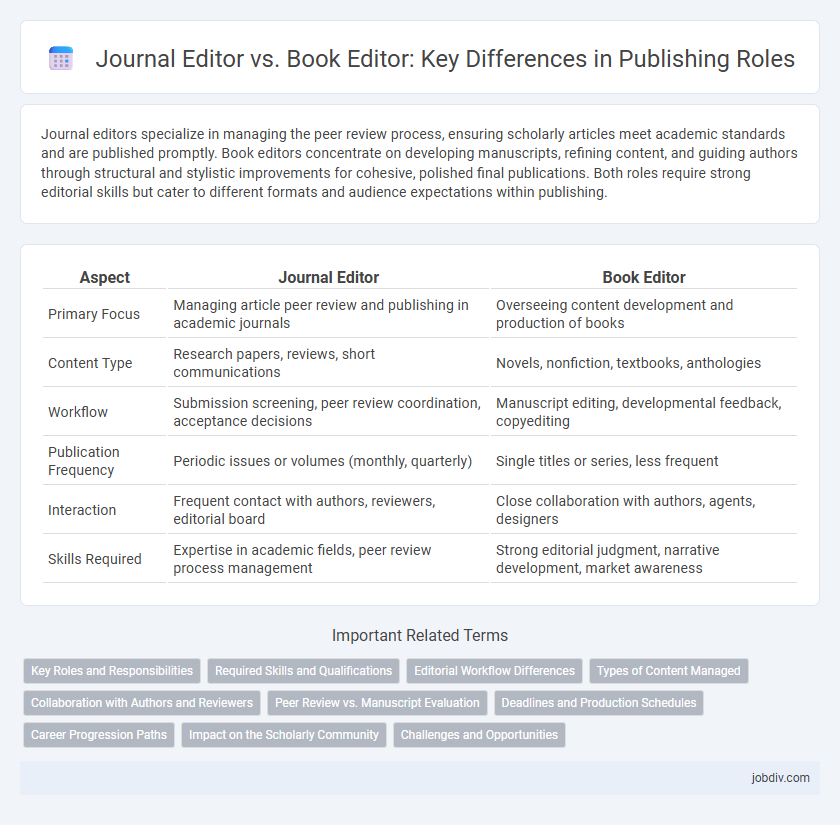Journal editors specialize in managing the peer review process, ensuring scholarly articles meet academic standards and are published promptly. Book editors concentrate on developing manuscripts, refining content, and guiding authors through structural and stylistic improvements for cohesive, polished final publications. Both roles require strong editorial skills but cater to different formats and audience expectations within publishing.
Table of Comparison
| Aspect | Journal Editor | Book Editor |
|---|---|---|
| Primary Focus | Managing article peer review and publishing in academic journals | Overseeing content development and production of books |
| Content Type | Research papers, reviews, short communications | Novels, nonfiction, textbooks, anthologies |
| Workflow | Submission screening, peer review coordination, acceptance decisions | Manuscript editing, developmental feedback, copyediting |
| Publication Frequency | Periodic issues or volumes (monthly, quarterly) | Single titles or series, less frequent |
| Interaction | Frequent contact with authors, reviewers, editorial board | Close collaboration with authors, agents, designers |
| Skills Required | Expertise in academic fields, peer review process management | Strong editorial judgment, narrative development, market awareness |
Key Roles and Responsibilities
Journal editors manage the peer review process, ensure the accuracy and relevance of research articles, and uphold publication ethics to maintain the journal's academic integrity. Book editors oversee manuscript development, coordinate with authors to refine content, and manage the production timeline to deliver a polished final product. Both roles require strong editorial judgment but differ in scope, with journal editors focusing on scholarly article curation and book editors emphasizing comprehensive content editing and project management.
Required Skills and Qualifications
Journal editors require strong expertise in subject matter, exceptional peer review management skills, and the ability to adhere strictly to publication timelines. Book editors need a keen eye for narrative structure, proficiency in various editing styles, and experience in long-form content development. Both roles demand excellent communication, attention to detail, and a thorough understanding of publishing standards.
Editorial Workflow Differences
Journal editors prioritize managing peer review processes, coordinating with reviewers to ensure timely feedback and revisions, focusing on maintaining rigorous academic standards. Book editors oversee developmental editing, manuscript acquisition, and collaboration with authors, emphasizing narrative flow and market appeal over strict review cycles. The editorial workflow for journals is cyclical and deadline-driven, while book editing follows a more linear and flexible timeline.
Types of Content Managed
Journal editors primarily manage scholarly articles, research papers, and peer-reviewed studies, ensuring content aligns with academic standards and advances knowledge in specific fields. Book editors oversee a broader range of content, including fiction, nonfiction, textbooks, and anthologies, focusing on narrative structure, style, and market appeal. The distinct content types reflect the specialized expertise and editorial processes unique to journals and book publishing.
Collaboration with Authors and Reviewers
Journal editors coordinate closely with authors and peer reviewers to ensure rigorous evaluation and timely revision of manuscripts, fostering a collaborative environment that enhances the quality of published research. Book editors work directly with authors throughout the developmental stages of a manuscript, offering in-depth guidance on structure, content, and style to refine the work before publication. Both roles require strong communication skills and the ability to mediate feedback, but journal editors emphasize scholarly review processes while book editors focus more on creative collaboration.
Peer Review vs. Manuscript Evaluation
Journal editors specialize in managing the peer review process, ensuring that submitted research articles undergo rigorous evaluation by experts to validate accuracy and originality. Book editors focus on manuscript evaluation, concentrating on the content's structure, coherence, and market suitability rather than subject-specific peer validation. The peer review process is critical in journals for maintaining scientific integrity, while manuscript evaluation in book publishing emphasizes narrative quality and editorial refinement.
Deadlines and Production Schedules
Journal editors manage strict, recurring deadlines aligned with issue publication dates, often coordinating simultaneous submissions and peer reviews to meet tight production schedules. Book editors work on longer timelines, allowing for extensive revisions and staggered production phases, balancing manuscript development with printing and marketing plans. Both roles require precise time management, but journal editing demands faster turnaround to maintain periodic publication consistency.
Career Progression Paths
Journal editors often follow a career progression that emphasizes expertise in a specific academic discipline, advancing through roles such as assistant editor, associate editor, and chief editor while building a strong network within scholarly communities. Book editors typically start as editorial assistants or junior editors, gaining experience in manuscript acquisition, developmental editing, and author relations before moving into senior editorial or acquisitions editor positions. Both career paths value a deep understanding of content curation and publishing workflows, but journal editors prioritize peer review management and academic credibility, whereas book editors focus on market trends and reader engagement.
Impact on the Scholarly Community
Journal editors shape the scholarly community by curating peer-reviewed research that drives academic discourse and advances specific fields. Book editors influence the community by refining comprehensive, in-depth works that synthesize knowledge and support educational curricula. Both roles are crucial for maintaining academic standards and disseminating validated knowledge across disciplines.
Challenges and Opportunities
Journal editors face tight deadlines and rigorous peer-review processes, balancing the need for timely publication with maintaining academic quality, which presents challenges in managing reviewer availability and manuscript revisions. Book editors encounter longer project timelines that involve working closely with authors on content development and market positioning, creating opportunities for deeper editorial collaboration and enhancing the book's impact. Both roles require strong communication skills and subject expertise to navigate the evolving publishing landscape and digital transformation effectively.
Journal Editor vs Book Editor Infographic

 jobdiv.com
jobdiv.com